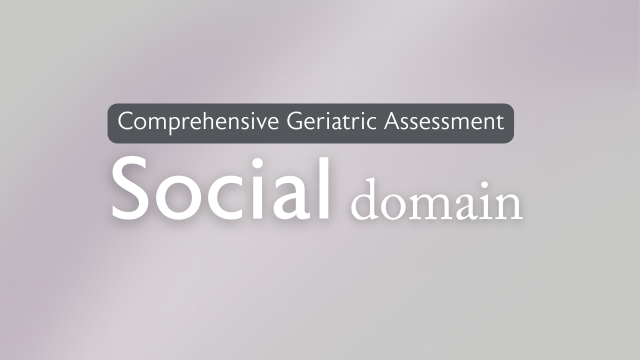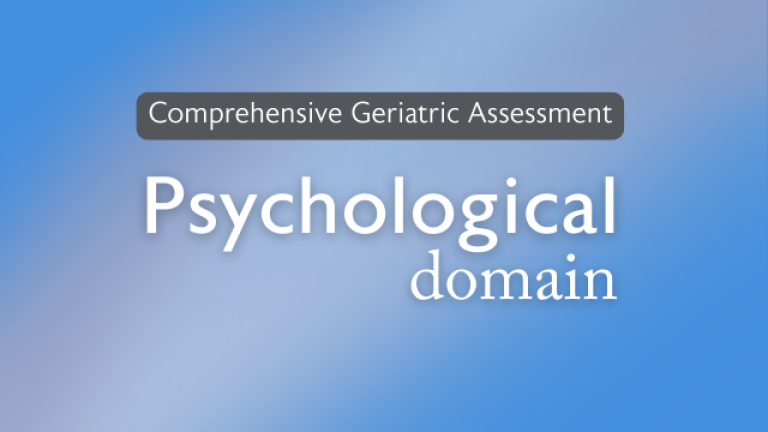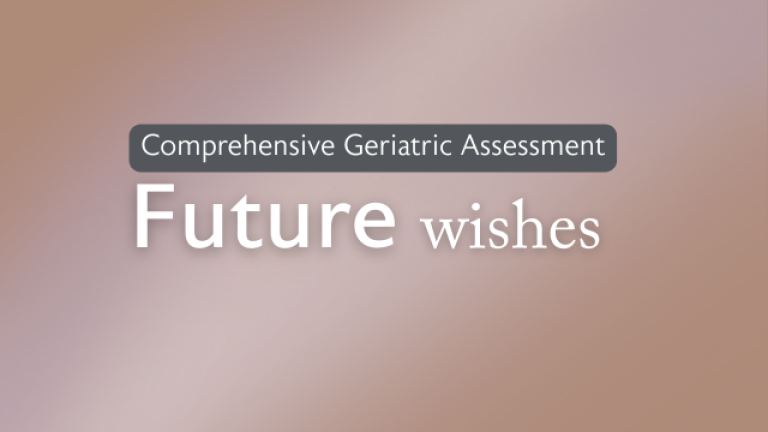Comprehensive Geriatric Assessment (CGA): Social domain
The social domain of CGA explores social support, carer needs, isolation, spiritual/religious beliefs and financial concerns. These aspects, combined with the other five domain areas, are essential for creating a comprehensive care plan.
Social integration is a key determinant of good health as we age,1 including proven positive effects on health, mental wellbeing2 and cognition.3 Data has demonstrated that older people who report feeling lonely show a decline in activities of daily living (ADLs), mobility and even have an increased risk of death.4
Social activity or participation may include things such as “meeting friends, attending events or functions, volunteering or participating in occupational duties or group recreational activities.”5
Social support can be divided into:5,6
- Emotional – reassurance of worth, empathy, affection
- Instrumental – material aid
- Informational – advice, guidance, feedback
Although each of these different areas of support are required to prevent loneliness, it must be remembered that each person will have their own perception about the support they need, and it can differ significantly between individuals. It is the quality of perceived support that determines how supported a person feels and demonstrates positive outcomes6, making it essential that any referrals or services must be based on individual, person-centred choices.
It is important to establish the social network available to the older person with frailty; this will include family, friends and any other social connections. Crucially it is important to also ascertain the accessibility of this network to the older adult – are they able to remain in touch with friends and family, does anything prevent this social inclusion? You may want to consider factors such as (this is not an exhaustive list):
- Mobility
- Digital literacy
- Relationship strain
- Financial difficulties
- Preference for independence
Living arrangements
A factor that may also greatly influence the accessibility of a social network and support is living arrangements – it is crucial during CGA to find out the living arrangements of the older adult, and how these are helping, or potentially hindering, their ability to live well with frailty. Evidence has shown that living alone can increase risk of frailty, though when split by gender this risk only affects men.7 As this is likely linked to loneliness, the accessibility of a social support network may mitigate these risks. This will include assessing the level of support available and how the person feels about their home situation, which ties in naturally to environmental and home safety discussions.
Financial circumstances
Finances can be a sensitive topic for people, but it is important to find out key information about this aspect of a person's life, particularly if financial worries may be negatively affecting their health and wellbeing. Often older adults may not be aware of financial help that could be available to them, so clear signposting can be valuable in relieving both financial and mental stress.
Formal financial assessment may be required if a person has care needs that require provision from outside agencies, and support on this can be found from local council websites and social services, as these will vary by area. People may also wish to appoint an attorney to help make financial decisions, known as lasting power of attorney (LPA) for health and welfare. Please note there are different processes for this in Scotland and Northern Ireland.
Other useful places to find financial information include:
-
Age UK offers helpful advice tailored for older people on financial and legal matters.
-
Citizens Advice provides free, confidential guidance on a wide range of everyday issues.
-
Turn2us helps individuals find financial support and understand the benefits they may be entitled to.
-
Gov.uk contains official government information, including details about power of attorney.
Veterans
A key aspect of personal history that may require more tailored social support is that of being a veteran. Veterans have been found to have an increased risk of anxiety, depression and higher alcohol consumption.8 In addition to this, veterans have reported in studies higher levels of loneliness that the general population, with “as many as 70% stating loneliness and social isolation as a problem.”9 A key factor in this research is that many veterans reported loneliness despite having a social network of close family and friends, but it was the lack of shared understanding of a military experience that led to feelings of loneliness.9 For this reason, veteran-specific support services can be a lifeline to this group of older adults.
Useful resources can be found at:
-
Gov.uk Veterans Support Directory provides official information and resources for veterans.
-
Help for Heroes offers support to veterans and their families.
-
SSAFA The Armed Forces Charity delivers welfare services for serving personnel, veterans, and their families.
-
For those working within areas of the country with high numbers of veterans, e.g. Hampshire, there are large local support networks available; Veterans Outreach Support.
-
Age UK LGBT+ Veteran support: Operation Sterling provides tailored advice and support for LGBT+ veterans.
Religious beliefs
A key area of social support for many older people may come from religious and/or spiritual beliefs. This is essential to discuss during conversations about future planning (link to section?) and can also provide valuable insights into social networks and inclusion. Studies have shown that religion and spirituality have a positive effect on “social support, connectedness to others and a sense of belonging to a community for older adults.”10 Attendance to religious settings has been found to provide older adults with many different types of social support, including emotional, help dealing with financial strain and even reduction in mortality.11 However, many faith leaders offer services for those who cannot attend places of worship in person, so mobility or travel restrictions should not be a barrier to practising faith. Ensuring that an older adult can continue to maintain their religious beliefs in a way that is meaningful to them can have significant positive effects on their wellbeing.
Social support
Social support is the opposite of loneliness, and as the latter can have profoundly negative effects on older adults, it is crucial to establish social factors during CGA. The support that a person may require will be individual, taking into account living arrangements, finances and individual factors such as previous military service.
The support network and its availability can greatly alter the options available to older adults with regards to discharge destination from inpatient settings, although care must be taken to consider the caring responsibilities required, particularly from informal carers. The Carers Trust can help find local caring services for those who don’t have informal care available.
We must be conscious of individual choice, and ensure that any support offered facilitates a person to live well in the way they choose, rather than what we would suggest for them. It is a skill to ensure that we do not place our own values on others, but rather view a ‘day in the life’ of the person, and provide options to enable them to live as they would like. Social workers and social prescribers are highly skilled at these conversations, and most primary care networks (PCNs) will now have access to a social prescriber who can establish ways to enhance wellbeing and connectedness to the local community.
Information on social prescribing can be found at the National Social Prescribing Academy, and the 5 steps to wellbeing can be a useful starter for these conversations.
Other useful places to find information include:
- Libraries
- Local council websites
- Facebook – following local groups
- VCSE (Voluntary, Community and Social Enterprise) – many towns and cities will have a VCSE collaborative which pulls together information on many local VCSE services
Formal and informal caregivers
Caregivers provide physical assistance, cognitive prompting and/or emotional support to older people. Many older people living with frailty are reliant upon caregiver support, and CGA must include an assessment of care needs and how they are currently being managed. This includes both formal and informal current care and whether the person’s needs are anticipated to change significantly, to establish appropriate future plans.
When cognition is impaired, it is often caregivers who can provide key information that supports management e.g. clarifying the recent history and functional capabilities aiding in diagnosis and setting appropriate rehabilitation goals.
While the input of formal carers can be relatively easily quantified, the contribution of informal carers can be harder to define. Informal care value has increased by 30% in the last decade and is now valued at £445M per day;12 this figure is similar to the daily spend across the whole of the NHS. Providing informal care for older adults is widespread; the UK census found that after the age of 50, the average individual will spend more than 5 years providing care,13 and data shows that 8% of the UK’s private household population were ‘informal carers’ for someone.14
In addition to providing vital collateral history and insight into a person’s beliefs and wishes, explicitly integrating caregivers in the discharge planning process has been shown to reduce readmissions by 25%.15
The care support needs of an individual can vary markedly, and will evolve and change over time. It is also important to note that many caregivers are themselves individuals living with ill health. For this reason, when assessing an older adult with frailty, it is vital to ascertain if they are themselves providing care and support for another, as well as establishing their own care needs.
Impact of caregiver stress and burnout
Consideration of caregiver stress or burden is essential during CGA, and can be defined as the physical, mental and emotional strain experienced by carers as a result of providing care16 and there are many factors that influence how much stress is perceived by the individual caregiver. “Stress” is influenced by the nature, intensity and the amount of care required but also by the nature of the previous relationship with the person they are caring for, the carers own health, support networks and resilience, community expectations and societal recognition of the caregiver role.
Higher intensity caregiver roles are linked with worse outcomes for patients and carers and can result in caregiver 'burnout'. Where care becomes unsustainable, avoidable harm or hospitalisation can ensue. The monitoring of carer stress is important in the holistic assessment of the domestic situation and can prevent avoidable ill health of both the cared for and the caregiver. Engaging carers in decision making is more likely to lead to successful ongoing care at home and to reduce the subsequent reports of carer stress and potentially burnout.
Caregiver stress and burnout can manifest in many ways; for example as sleep disturbance, anxiety, low mood and depression but stress can also lead to resentment and occasionally to harm and abuse. Inquiring and exploring the possibility of caregiver stress needs to be done tactfully. There are a number of standard rating scales that can be employed to screen for Caregiver stress (e.g. Zarit, Caregiver strain index)
Carers may benefit from additional formal care to support their role or a period of respite. It is important to note that impact and emotions will be individual; if an older person with frailty moves into a 24-hour care facility it may be perceived externally as a positive for the caregiver, but there is no guarantee they will find this a less stressful situation.
Supporting carers can provide long term benefits, enhancing the quality of life of carer and the person being cared for.17 Caregivers in the UK are entitled to assessments18 via local councils to establish how they can be supported in their role, which is a valuable resource to direct to during CGA.
From a health perspective, optimising medical conditions, improving the care environment and providing specialist support can contribute to reducing care dependency. Thorough history taking is key; by understanding the type of care support required, nature of relationships and tensions (where they exist) problems in care provision can be averted and caregiver stress and burnout can be minimised.
References
References
Click to expand
- Cohen S. Social support measurement and intervention. Social support measurement and intervention. A guide for 356 health and social scientists. 2000:13.
- Siette J, Pomare C, Dodds L, Jorgensen M, Harrigan N, Georgiou A. A comprehensive overview of social network measures for older adults: A systematic review. Archives of Gerontology and Geriatrics, Volume 97, 2021, 104525, ISSN 0167-4943. https://doi.org/10.1016/j.archger.2021.104525.
- Kelly, M.E., Duff, H., Kelly, S. et al. The impact of social activities, social networks, social support and social relationships on the cognitive functioning of healthy older adults: a systematic review. Syst Rev 6, 259 (2017). https://doi.org/10.1186/s13643-017-0632-2.
- C.M. Perissinotto, I.S. Cenzer, K.E. Covinsky. Loneliness in older persons: A predictor of functional decline and death. Archives of Internal Medicine, 172 (14) (2012), pp. 1078-1084.
- L.F. Berkman, T. Glass, I. Brissette, T.E. Seeman. From social integration to health: Durkheim in the new millennium. Social Science & Medicine, 51 (6) (2000), pp. 843-857, 10.1016/s0277-9536(00)00065-4.
- Drageset J. Social Support. 2021 Mar 12. In: Haugan G, Eriksson M, editors. Health Promotion in Health Care – Vital Theories and Research [Internet]. Cham (CH): Springer; 2021. Chapter 11. Available from: https://www.ncbi.nlm.nih.gov/books/NBK585650/ doi: 10.1007/978-3-030-63135-2_11.
- Gotaro Kojima, Yu Taniguchi, Akihiko Kitamura, Yoshinori Fujiwara, Is living alone a risk factor of frailty? A systematic review and meta-analysis, Ageing Research Reviews, Volume 59, 2020, 101048, ISSN 1568-1637, https://doi.org/10.1016/j.arr.2020.101048.
- Finnegan, A. & Randles, R. (2022). Prevalence of common mental health disorders in military veterans: using primary healthcare data. BMJ Military Health, p. e002045.
- Royal British Legion (2018). Loneliness and Social Isolation in The Armed Forces Community. Royal British Legion.
- Koenig H.G. Religion, Spirituality, and Health: The Research and Clinical Implications. Int. Sch. Res. Netw. Psychiatr. 2012:1–33. doi: 10.5402/2012/278730.
- Krause N. Church-based social support and mortality. Journal of Gerontology. 2006;61B(3):s140–s146. doi: 10.1093/geronb/61.3.s140.
- Carers UK: Valuing carers research report https://www.carersuk.org/reports/valuing-carers-research-report/
- Colombo F, Llena-Nozal A, Mercier J, Tjadens F. Help Wanted? Providing and Paying for Long-Term Care. OECD Health Policy Studies, OECD Publishing ;
- ONS, 2017. Unpaid carers provide social care worth £57 billion. https://www.ons.gov.uk/peoplepopulationandcommunity/healthandsocialcare/healthandlifeexpectancies/articles/unpaidcarersprovidesocialcareworth57billion/2017-07-10. 2011. http://dx.doi.org/10.1787/9789264097759-en. [Google Scholar]
- Caregiver Integration during Discharge Planning of Older Adults to Reduce Resource Utilization: A Systematic Review and MetaAnalysis of Randomized Controlled Trials. Rodakowski et al. J Am Geriatr Soc. 2017 August ; 65(8): 1748–1755. doi:10.1111/jgs.14873.
- Liu Z, Heffernan C, Tan J. Caregiver burden: A concept analysis. Int J Nurs Sci. 2020 Jul 25;7(4):438-445. doi: 10.1016/j.ijnss.2020.07.012. PMID: 33195757; PMCID: PMC7644552.
- Caregiver influences on ‘living well’ for people with dementia: Findings from the IDEAL study. Quinn et al. AGING & MENTAL HEALTH 2020, VOL. 24, NO. 9, 1505–1513 https://doi.org/10.1080/13607863.2019.1602590
- NHS: Carer’s assessments https://www.nhs.uk/social-care-and-support/support-and-benefits-for-carers/carer-assessments/






